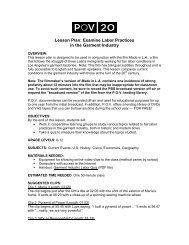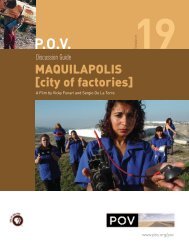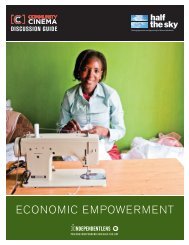LESSON PLANS - ITVS
LESSON PLANS - ITVS
LESSON PLANS - ITVS
- No tags were found...
You also want an ePaper? Increase the reach of your titles
YUMPU automatically turns print PDFs into web optimized ePapers that Google loves.
HALF THE SKY: MATERNAL MORTALITYStudent Handout E:Maternal Mortality Fact Sheet (page 1)What are the causes of maternal death? Women die as a result of medical complications that happen duringand following pregnancy, often because the medical care and resources needed are too far away, unavailable,inadequate, or unaffordable. Below is a list of the major complications that account for 80 percent of allmaternal deaths all of which are treatable if resources and skilled healthcare workers are available:• Hemorrhaging: Severe bleeding, mostly occurring after childbirth• Infection: Most commonly occurring after and as a result of childbirth• Pre-eclampsia and Eclampsia: A set of symptoms including highblood pressure that occurs during pregnancy and can lead toseizures and coma during labor.• Obstructed labor: Difficult labor, which may be caused by anobstruction or constriction of the birth passage• Indirect causes: Approximately 20 percent of maternal deathsresult from diseases or physical traumas unrelated to pregnancythat are aggravated by pregnancy, such as anemia, malaria,hepatitis, diabetes, HIV/AIDS, and physical and sexual abuse.Why do women die?Understanding the medical causes of maternal mortality only givesus part of the story. Maternal death is the result of a complex webof social, political, and economic forces that undermines women’saccess to essential maternal healthcare. A high maternal death rateindicates that the fundamental rights to life and health for women arebeing violated. Contributing factors to maternal mortality include:• Poverty• Gender-based discrimination• Limited access to affordable, quality healthcare• Limited access to family planning• Limited access to education• Cultural practices• Adolescent Maternity• Poverty: Being poor limits a woman’s access to information andhealthcare. Factors such as malnutrition, disease, lack of cleanwater, and inadequate medical care make pregnancy and childbirtha dangerous experience for women living in extreme poverty.• Gender-Based Discrimination: Maternal mortality rates are also aneffective measure of women’s place in society. In countries wherewomen are devalued they lack access to education, economicopportunities, social supports, and leadership and decision-makingopportunities that contribute to higher maternal mortality rates.• Limited Access to Affordable, Quality Healthcare: Many womencannot use health services during pregnancy and childbirthbecause their families simply cannot afford the costs. And if theylive in a poor community, the available healthcare may be poor aswell. Key factors that continue to contribute to the large number ofwomen dying include: too few or untrained health workers, a lackof equipment and supplies, unavailable transportation, insufficientfunds, and a lack extended services including family planning andpostnatal care.• Limited Access to Family Planning: Having large numbers ofchildren with short recovery periods between pregnancies isdetrimental to women’s health. If women had only the number ofpregnancies they wanted, at the intervals they wanted, maternalmortality would drop by about one-third.• Limited Access to Education: When women are better educatedthey have a better chance of surviving childbirth. Educated womenare also more likely to have wage-earning jobs that give themgreater decision-making roles in a family’s finances and enablethem to save money and afford health-care when it is most needed.According to the World Bank, for every 1,000 girls who get anadditional year of education, two fewer women will die in childbirth.• Cultural Practices: In some cultures, seeking medical help isseen as a sign of weakness and pregnant women in the poorestcountries are often tended to by family or traditional birthingassistants who may have little or no medical training and who mayuse traditional practices that could complicate pregnancies andworsen a mother’s condition.• Adolescent Maternity: Child marriage contributes greatly toadolescent maternal mortality rates. Currently, an estimated 51million girls under the age of 18 are married, and over the nextdecade, it is estimated that another 100 million girls will becomechild brides. Studies show that adolescents age 15 through 19 aretwice as likely to die during pregnancy or childbirth as those overage 20, and girls under age 15 are five times more likely to die.
















